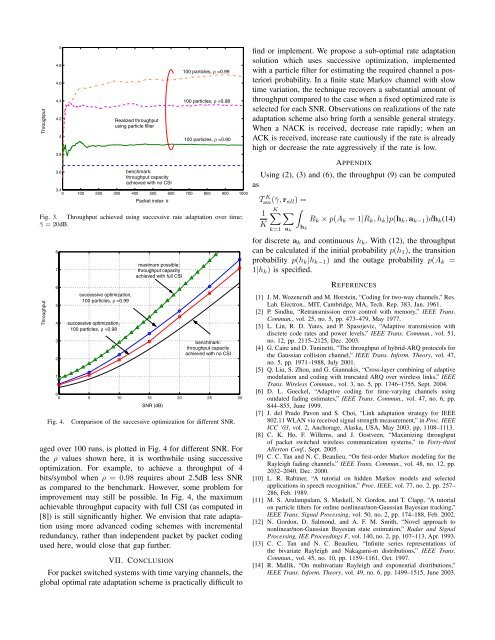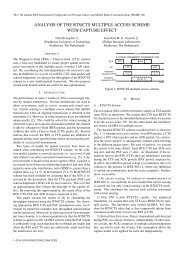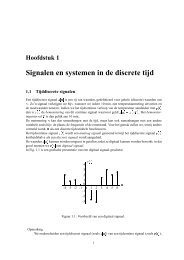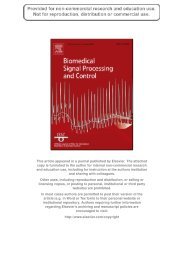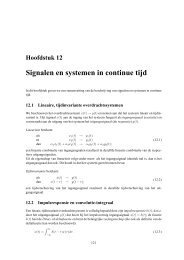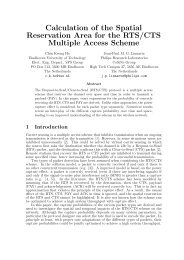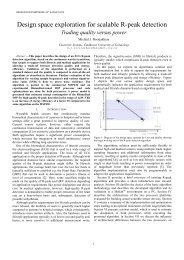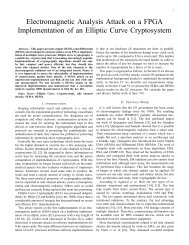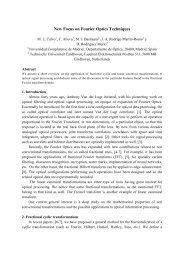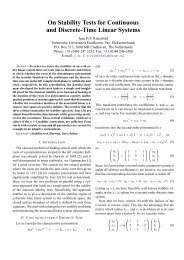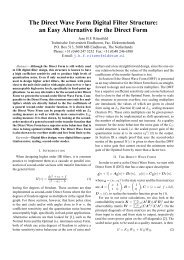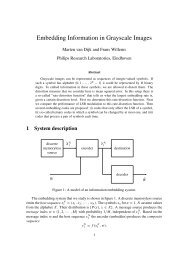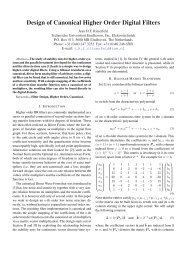Rate Adaptation in Time Varying Channels using Acknowledgement ...
Rate Adaptation in Time Varying Channels using Acknowledgement ...
Rate Adaptation in Time Varying Channels using Acknowledgement ...
You also want an ePaper? Increase the reach of your titles
YUMPU automatically turns print PDFs into web optimized ePapers that Google loves.
Throughput<br />
5<br />
4.8<br />
4.6<br />
4.4<br />
4.2<br />
4<br />
3.8<br />
3.6<br />
Realized throughput<br />
us<strong>in</strong>g particle filter<br />
benchmark:<br />
throughput capacity<br />
achieved with no CSI<br />
3.4<br />
0 100 200 300 400 500 600 700 800 900 1000<br />
Packet <strong>in</strong>dex k<br />
100 particles, ρ =0.99<br />
100 particles, ρ =0.98<br />
100 particles, ρ =0.90<br />
Fig. 3. Throughput achieved us<strong>in</strong>g successive rate adaptation over time;<br />
¯γ =20dB.<br />
Throughput<br />
8<br />
7<br />
6<br />
5<br />
4<br />
3<br />
2<br />
1<br />
successive optimization,<br />
100 particles, ρ =0.99<br />
successive optimization,<br />
100 particles, ρ =0.98<br />
maximum possible:<br />
throughput capacity<br />
achieved with full CSI<br />
0<br />
0 5 10 15 20 25 30<br />
Fig. 4.<br />
SNR (dB)<br />
benchmark:<br />
throughput capacity<br />
achieved with no CSI<br />
Comparison of the successive optimization for different SNR.<br />
aged over 100 runs, is plotted <strong>in</strong> Fig. 4 for different SNR. For<br />
the ρ values shown here, it is worthwhile us<strong>in</strong>g successive<br />
optimization. For example, to achieve a throughput of 4<br />
bits/symbol when ρ =0.98 requires about 2.5dB less SNR<br />
as compared to the benchmark. However, some problem for<br />
improvement may still be possible. In Fig. 4, the maximum<br />
achievable throughput capacity with full CSI (as computed <strong>in</strong><br />
[8]) is still significantly higher. We envision that rate adaptation<br />
us<strong>in</strong>g more advanced cod<strong>in</strong>g schemes with <strong>in</strong>cremental<br />
redundancy, rather than <strong>in</strong>dependent packet by packet cod<strong>in</strong>g<br />
used here, would close that gap further.<br />
VII. CONCLUSION<br />
For packet switched systems with time vary<strong>in</strong>g channels, the<br />
global optimal rate adaptation scheme is practically difficult to<br />
f<strong>in</strong>d or implement. We propose a sub-optimal rate adaptation<br />
solution which uses successive optimization, implemented<br />
with a particle filter for estimat<strong>in</strong>g the required channel a posteriori<br />
probability. In a f<strong>in</strong>ite state Markov channel with slow<br />
time variation, the technique recovers a substantial amount of<br />
throughput compared to the case when a fixed optimized rate is<br />
selected for each SNR. Observations on realizations of the rate<br />
adaptation scheme also br<strong>in</strong>g forth a sensible general strategy.<br />
When a NACK is received, decrease rate rapidly; when an<br />
ACK is received, <strong>in</strong>crease rate cautiously if the rate is already<br />
high or decrease the rate aggressively if the rate is low.<br />
APPENDIX<br />
Us<strong>in</strong>g (2), (3) and (6), the throughput (9) can be computed<br />
as<br />
T K<br />
ave(¯γ,r all )=<br />
1<br />
K∑ ∑<br />
∫<br />
R k × p(A k =1|R k ,h k )p(h k , a k−1 )dh k (14)<br />
K<br />
k=1 a k<br />
h k<br />
for discrete a k and cont<strong>in</strong>uous h k . With (12), the throughput<br />
can be calculated if the <strong>in</strong>itial probability p(h 1 ), the transition<br />
probability p(h k |h k−1 ) and the outage probability p(A k =<br />
1|h k ) is specified.<br />
REFERENCES<br />
[1] J. M. Wozencraft and M. Horste<strong>in</strong>, “Cod<strong>in</strong>g for two-way channels,” Res.<br />
Lab. Electron., MIT, Cambridge, MA, Tech. Rep. 383, Jan. 1961.<br />
[2] P. S<strong>in</strong>dhu, “Retransmission error control with memory,” IEEE Trans.<br />
Commun., vol. 25, no. 5, pp. 473–479, May 1977.<br />
[3] L. L<strong>in</strong>, R. D. Yates, and P. Spasojevic, “Adaptive transmission with<br />
discrete code rates and power levels,” IEEE Trans. Commun., vol. 51,<br />
no. 12, pp. 2115–2125, Dec. 2003.<br />
[4] G. Caire and D. Tun<strong>in</strong>etti, “The throughput of hybrid-ARQ protocols for<br />
the Gaussian collision channel,” IEEE Trans. Inform. Theory, vol. 47,<br />
no. 5, pp. 1971–1988, July 2001.<br />
[5] Q. Liu, S. Zhou, and G. Giannakis, “Cross-layer comb<strong>in</strong><strong>in</strong>g of adaptive<br />
modulation and cod<strong>in</strong>g with truncated ARQ over wireless l<strong>in</strong>ks,” IEEE<br />
Trans. Wireless Commun., vol. 3, no. 5, pp. 1746–1755, Sept. 2004.<br />
[6] D. L. Goeckel, “Adaptive cod<strong>in</strong>g for time-vary<strong>in</strong>g channels us<strong>in</strong>g<br />
outdated fad<strong>in</strong>g estimates,” IEEE Trans. Commun., vol. 47, no. 6, pp.<br />
844–855, June 1999.<br />
[7] J. del Prado Pavon and S. Choi, “L<strong>in</strong>k adaptation strategy for IEEE<br />
802.11 WLAN via received signal strength measurement,” <strong>in</strong> Proc. IEEE<br />
ICC ’03, vol. 2, Anchorage, Alaska, USA, May 2003, pp. 1108–1113.<br />
[8] C. K. Ho, F. Willems, and J. Oostveen, “Maximiz<strong>in</strong>g throughput<br />
of packet switched wireless communication systems,” <strong>in</strong> Forty-third<br />
Allerton Conf., Sept. 2005.<br />
[9] C. C. Tan and N. C. Beaulieu, “On first-order Markov model<strong>in</strong>g for the<br />
Rayleigh fad<strong>in</strong>g channels,” IEEE Trans. Commun., vol. 48, no. 12, pp.<br />
2032–2040, Dec. 2000.<br />
[10] L. R. Rab<strong>in</strong>er, “A tutorial on hidden Markov models and selected<br />
applications <strong>in</strong> speech recognition,” Proc. IEEE, vol. 77, no. 2, pp. 257–<br />
286, Feb. 1989.<br />
[11] M. S. Arulampalam, S. Maskell, N. Gordon, and T. Clapp, “A tutorial<br />
on particle filters for onl<strong>in</strong>e nonl<strong>in</strong>ear/non-Gaussian Bayesian track<strong>in</strong>g,”<br />
IEEE Trans. Signal Process<strong>in</strong>g, vol. 50, no. 2, pp. 174–188, Feb. 2002.<br />
[12] N. Gordon, D. Salmond, and A. F. M. Smith, “Novel approach to<br />
nonl<strong>in</strong>ear/non-Gaussian Bayesian state estimation,” Radar and Signal<br />
Process<strong>in</strong>g, IEE Proceed<strong>in</strong>gs F, vol. 140, no. 2, pp. 107–113, Apr. 1993.<br />
[13] C. C. Tan and N. C. Beaulieu, “Inf<strong>in</strong>ite series representations of<br />
the bivariate Rayleigh and Nakagami-m distributions,” IEEE Trans.<br />
Commun., vol. 45, no. 10, pp. 1159–1161, Oct. 1997.<br />
[14] R. Mallik, “On multivariate Rayleigh and exponential distributions,”<br />
IEEE Trans. Inform. Theory, vol. 49, no. 6, pp. 1499–1515, June 2003.


